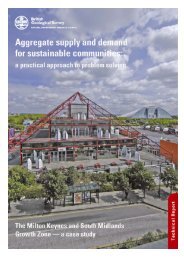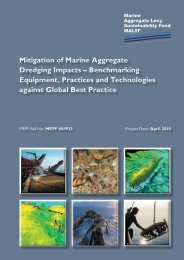creating environmental improvements through biodiversity
creating environmental improvements through biodiversity
creating environmental improvements through biodiversity
Create successful ePaper yourself
Turn your PDF publications into a flip-book with our unique Google optimized e-Paper software.
The Place: Clear Creek begins high in the Rocky Mountains, near the Loveland Basin in Colorado. Melting<br />
winter snows descend from heights in excess of 14,000 feet above sea level to Denver and, ultimately, the<br />
Gulf of Mexico. Clear Creek is like many headwater streams in the Western United States, where 40% of the<br />
waters do not meet water quality standards due to metals pollution. For millennia this stream provided a<br />
robust habitat for fish, including Colorado’s signature fish, the Greenback Cutthroat Trout.<br />
The Problem: Beginning in the mid-nineteenth century, mining for precious metals, including placer<br />
mining, contaminated the stream with toxic metals that ultimately led to the area around Idaho Springs and<br />
Blackhawk, Colorado, being declared a Superfund site under the Comprehensive Environmental Response,<br />
Compensation, and Liability Act. The area of specific interest is near the town of Golden called The Golden<br />
Mile, which has been affected by sedimentation, channelization, bank erosion, and the chemical effects of<br />
mining. Consequently, this segment lacks the diversity in depth, cover, bottom and edge strata, plant life and<br />
sinuosity necessary to support a substantial fishery.<br />
The Partners: For several years the West Denver Chapter of Trout Unlimited has been an active<br />
participant in a number of community-based initiatives dealing with impacts to Clear Creek, the Upper Clear<br />
Creek Watershed Association and the Clear Creek Foundation. Partners in the Clear Creek Watershed<br />
effort include all local communities; major industries, including the Henderson Mine, Loveland Ski Area<br />
and Coors Brewing Company; county governments; state agencies, including the Water Quality Control<br />
Division, the Division of Minerals and Geology, the Department of Transportation, the Division of Wildlife,<br />
the Department of Local Affairs and the Colorado School of Mines; and federal agencies, including EPA, U.S.<br />
Forest Service, U.S. Geological Survey, U.S. Fish and Wildlife Service, the Army Corps of Engineers and the<br />
Bureau of Land Management<br />
The Price: The total estimated cost for the stream restorations is $204,273, with funds from the Fishing<br />
is Fun grant programme accounting for $74,000. Industry donation is estimated at $26,000, while cash<br />
donations total $72,515 from the City of Golden, West Denver Chapter of Trout Unlimited and privatesector<br />
donors. In-kind volunteer time equates to $31,750.<br />
Primary Points: This project was initiated by a local chapter with technical assistance from the staff of Trout<br />
Unlimited. The roles of the partners have included funding, political support, focus and direction. This is just<br />
the first step in a long-term effort to restore the entire watershed in cooperation with various stakeholders.<br />
Sustainable Aggregates Creating Environmental Improvements <strong>through</strong> Biodiversity<br />
Resources Available<br />
Trout Unlimited has pulled together different kinds of financial and in-kind support for each project within<br />
the initiative <strong>through</strong> partnership with a wide range of sectors and organizations. Each project uses a<br />
combination of different resources from different partners that includes private landowners, local land users,<br />
mining and related industries, conservation organizations, local/state/federal agencies and Trout Unlimited<br />
chapters.<br />
In 2004, Trout Unlimited members volunteered approximately 425,000 hours on local projects across the<br />
country.<br />
Legislative/Policy Framework<br />
Limiting liability for groups doing abandoned mine cleanup is critical in securing their involvement in<br />
expanding cleanup operations from public to private lands. Federal legislation is a major barrier to abandoned<br />
mine restoration in this region. Organizations wanting to get involved can be discouraged by laws that would<br />
hold them responsible should they accidentally cause more pollution in their cleanup efforts. Under federal<br />
law, anyone who takes over a polluted site must assume the financial and legal burden of cleaning up the<br />
entire problem. Liability for potential harm caused by disturbing mine tailings is considered to be a major<br />
limiting factor for managing multi-stakeholder partnerships. Legislation is needed that would limit the liability<br />
101

















